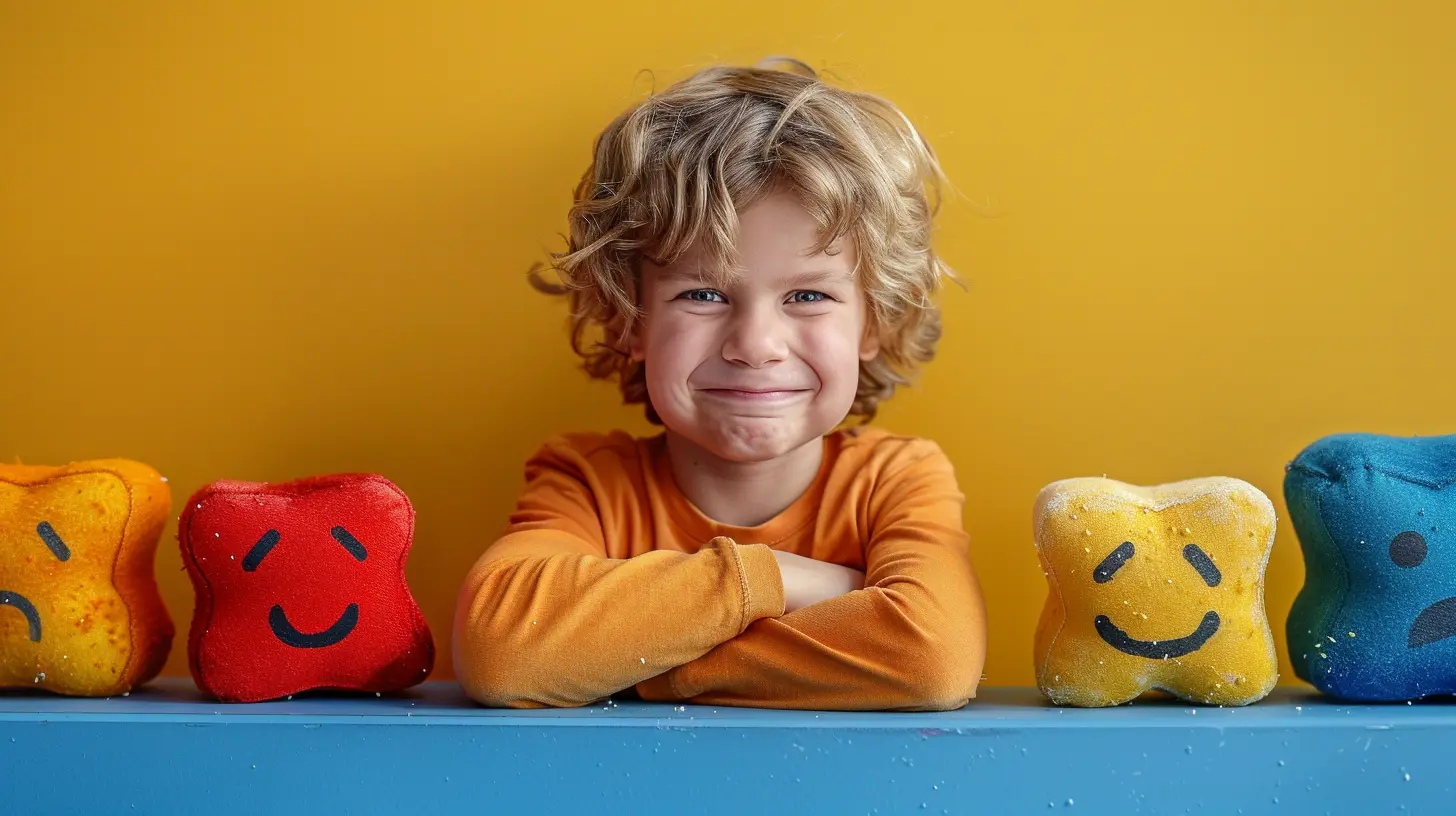How to Set Age-Appropriate Emotional Boundaries
18 July 2025
Parenting is a wild ride, isn’t it? One minute, you’re trying to get a toddler to stop licking the dog, and the next, you're navigating your teen's emotional storms over a TikTok video. While there’s no manual for raising emotionally healthy kids, one of the most powerful tools in your parenting arsenal is teaching emotional boundaries.
So—what does that even mean? And how do you tailor those boundaries to suit your child’s age? That’s exactly what we’re getting into.
Grab a cup of coffee, take a deep breath, and let’s talk real about how to set age-appropriate emotional boundaries with your kids.
What Are Emotional Boundaries, Anyway?
Before we jump into the age stuff, let’s get this straight: emotional boundaries are the mental fences we set to protect our feelings and manage the emotional energy we give and receive from others.They're the unspoken rules that help kids understand things like:
- When it's okay (and not okay) to share emotions
- How to say "no" without guilt
- How to respect other people’s emotions without taking them on as their own
Think of emotional boundaries like the invisible bubble that protects your child's mental well-being. They help kids identify their feelings, express them in healthy ways, and build respectful relationships—all crucial stuff for growing into emotionally intelligent adults.
Why Do Emotional Boundaries Matter?
Because kids are sponges. They soak up everything—your words, your reactions, your body language. Without emotional boundaries, kids can feel overwhelmed, responsible for other people’s feelings, or unsure about how to handle their own.Imagine a 7-year-old trying to handle a parent's stress or a teen being guilt-tripped into sharing something they're not ready to. That’s heavy. Emotional boundaries make sure your child grows up knowing it’s okay to feel things without carrying the emotional weight of the world.
The Golden Rule of Emotional Boundaries: One Size Doesn’t Fit All
Kids aren’t born knowing how to set healthy boundaries—it’s a learned skill. And just like learning to walk or speak, emotional boundaries develop over time.That’s why understanding what’s age-appropriate is key. If you expect a toddler to tell you when they feel emotionally drained... yeah, good luck with that. But by the time they're teens? That should absolutely be on the table.
Let’s dive into the different age groups and how to guide your child through building these boundaries—step-by-step.
Toddlers (Ages 1-3): Laying the Foundation
Okay, so toddlers have the emotional range of a soap opera actor. One second they’re giggling, the next they’re melting down because their banana broke in half. These emotional rollercoasters are normal—they’re just starting to figure out the big world of feelings.What Emotional Boundaries Look Like:
- Learning the names for emotions (“I see you're mad because we stopped playing.”)- Hearing that it's okay to say "no" (yes, even if it means saying no to Grandma's hugs!)
- Teaching that other people's feelings don’t always reflect their own
Your Job:
Start introducing language around feelings early on. Model emotional self-awareness. And most importantly—respect their boundaries when they set them.For example, if your toddler refuses a hug, don't force it. Tell them it's okay to not want physical affection sometimes. This shows them their body and emotions are theirs to own.
Preschoolers (Ages 3-5): Building Awareness
Preschoolers are like little scientists—curious, messy, and always experimenting, even with emotions. They start to grasp that other people have feelings, too. That’s your golden window to teach empathy and emotional separation.What Emotional Boundaries Look Like:
- Being able to say “I don’t like that” or “That hurt my feelings”- Beginning to understand personal space
- Learning that others are responsible for their own emotions
Your Job:
Repeat this phrase often: “You can be kind and still say no.”Encourage your child to express their needs and comfort levels. If a friend takes their toy and they get upset, help them use words to express that instead of lashing out. Don’t just punish the reaction—guide the emotion underneath.
Preschoolers are also big on mimicry. So show them how you set boundaries in your own life. Say things like, “Mommy needs a quiet break right now, I’ll play with you in 10 minutes.” That way, they see healthy boundaries modeled in action.
Early Elementary (Ages 6-9): Reinforcing Boundaries
At this stage, kids are ready for deeper conversations. They're starting to learn rules, fairness, and right vs. wrong. This is prime time to build emotional boundaries that hold up.What Emotional Boundaries Look Like:
- Expressing feelings clearly without guilt or shame- Knowing it’s okay to disagree with friends or family
- Understanding emotional limits (e.g., “I need a break from this conversation.”)
Your Job:
Give your child permission to feel without judgment. Validate their feelings—even when they’re dramatic (because, let’s be honest, drama is the elementary school currency).Teach them emotional scripts like:
- “I don’t want to talk about that right now.”
- “It makes me uncomfortable when you say that.”
- “Can we talk about this later?”
Also, reinforce that it's not their job to fix how others feel. For example, if a sibling is mad, your child doesn’t have to “make it better.” This encourages emotional autonomy and prevents people-pleasing patterns down the road.
Preteens (Ages 10-12): Embracing Independence
Now things start to heat up. Preteens are on that awkward bridge between childhood and adolescence. Their social world expands—and so does their emotional complexity.What Emotional Boundaries Look Like:
- Choosing what emotions to share and with whom- Feeling confident in saying “no” to emotional pressure
- Knowing when they need space without feeling guilty
Your Job:
Support their growing independence without pushing too hard. Let them set emotional limits—even with you.This might mean respecting their privacy when they say, “I don’t want to talk about it right now.” Don’t take it as rejection. It’s a sign they’re learning to self-regulate.
Encourage them to journal or find safe outlets for emotions. Reinforce that they’re allowed to not feel okay, and they don’t owe anyone an explanation for their emotions.
This is also a great time to introduce them to emotional boundaries in digital spaces. Talk about how it’s okay to mute threads, block someone, or take breaks from group chats that make them feel drained.
Teenagers (Ages 13-18): Respecting the Wall While Staying Connected
Ah, the teenage years. Full of eye rolls, slamming doors, and complicated feelings. But underneath all that sass? Your teen is carving out who they are. And emotional boundaries play a massive role in that process.What Emotional Boundaries Look Like:
- Maintaining emotional privacy- Enforcing limits with peers (think toxic friendships or romantic drama)
- Recognizing manipulation or emotional gaslighting
Your Job:
Respect their emotional independence while keeping communication lines wide open. Listen more than you talk. Offer support without prying. Show up without smothering.Teens need space to set boundaries with you and others. They’re testing limits—not just yours, but their own.
Help them role-play scenarios where they can assert themselves:
- “I care about you, but I don’t feel like talking right now.”
- “That’s not something I’m comfortable sharing.”
- “This conversation is making me upset—I’m going to take a break.”
Also, check your own boundaries. Are you oversharing your adult problems with your teen? Are you expecting emotional support from them that should come from another adult? That’s a hard pill to swallow but super important.
Common Mistakes Parents Make—and How to Fix Them
Even well-meaning parents mess up sometimes. It's part of the journey. Here are a few boundary-busting habits to avoid—and quick fixes:1. Oversharing Your Emotions
Your child isn’t your therapist. If you're going through something big emotionally, it’s okay to be honest (“Mom’s feeling a little sad today”) but don’t offload everything on them.✔️ Fix: Get support from other adults when needed.
2. Dismissing Their Feelings
“Don’t cry,” “Get over it,” or “That’s not a big deal” crush emotional boundaries fast. These phrases shut kids down—and they learn to bottle things up.✔️ Fix: Validate first. “I see that upset you. Want to talk about it?”
3. Not Respecting Their “No”
Whether it’s hugging a relative, sharing a secret, or talking about a breakup—if your child says no, respect it.✔️ Fix: Let them set the pace for emotional conversations, within reason.
Teaching by Example: The Most Powerful Tool You Have
Kids learn way more from what you do than what you say. If you're constantly burning yourself out trying to be everything to everyone, that's what they'll learn too.Start modeling boundaries in your own life:
- Say no without guilt
- Communicate your emotional needs calmly
- Take responsibility for your own feelings
When kids watch you protect your emotional space, they’ll feel empowered to protect theirs.
Final Thoughts: Boundaries That Grow With Them
Setting emotional boundaries isn't a one-and-done deal. As your child grows, their needs change, and so should your approach. But here’s the thing—when you teach your kid how to honor their emotional world, you're not just raising a child. You're raising a confident, empathetic, self-aware human being.And that? That’s the kind of legacy that lasts.
So take it one conversation at a time, meet them where they're at, and remember—emotional boundaries aren't about shutting people out; they're about teaching your kids how to let the right people in.
all images in this post were generated using AI tools
Category:
Mental HealthAuthor:

Maya Underwood
Discussion
rate this article
1 comments
Greyson Jenkins
Setting age-appropriate emotional boundaries is crucial for fostering healthy development. Start by encouraging open communication, teaching empathy, and modeling boundary-setting behaviors. Remember, consistency is key; children thrive when they understand limits and feel secure in their emotional environment.
August 1, 2025 at 4:49 PM

Maya Underwood
Thank you for highlighting the importance of open communication and consistency in setting emotional boundaries. These practices are essential for a child's healthy development!


